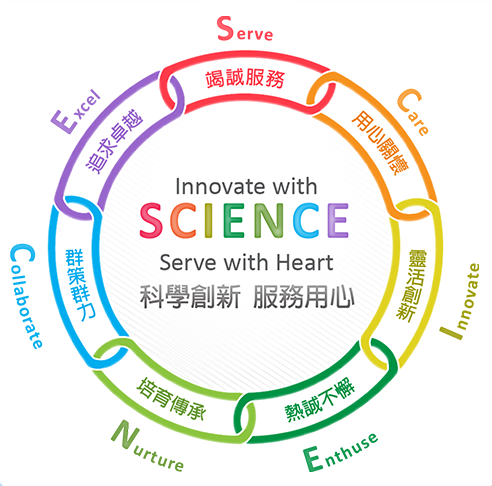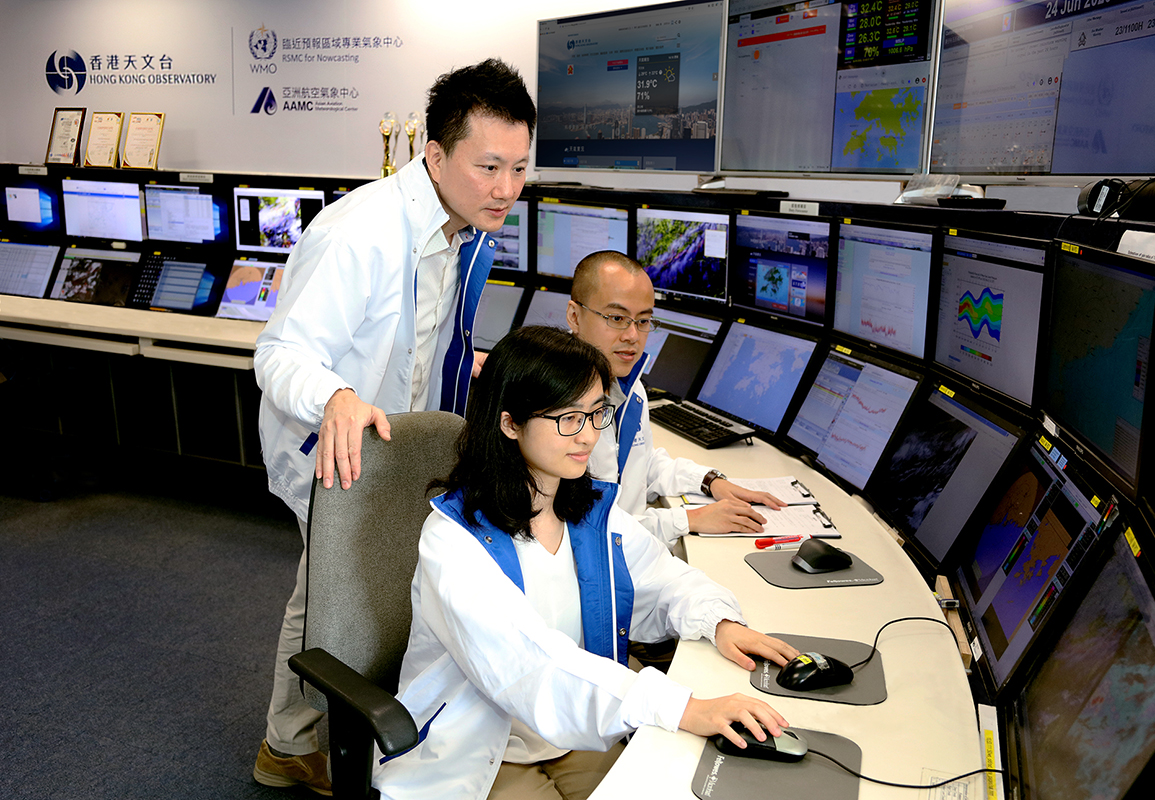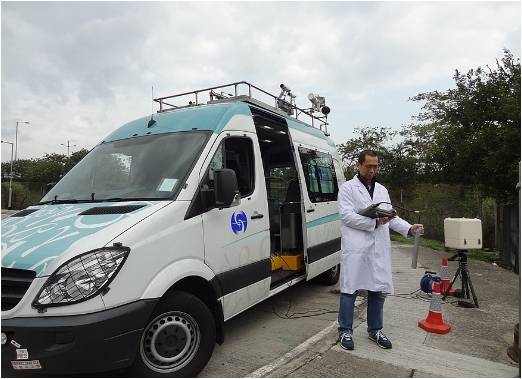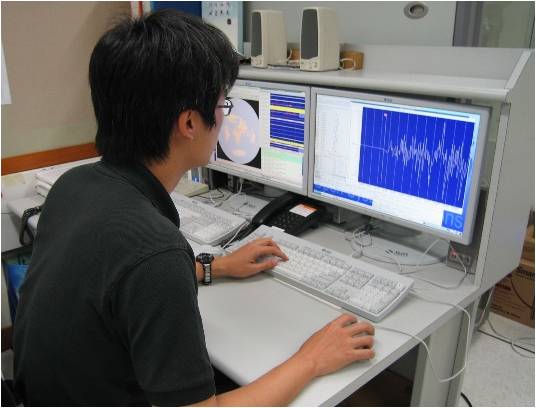Hong Kong Observatory - The Facts
The Hong Kong Observatory is a government department responsible for monitoring and forecasting weather, as well as issuing warnings on weather-related hazards. The Observatory also monitors and assesses radiation levels in Hong Kong, and provides other meteorological and geophysical services to meet the needs of the public, special users, the shipping and aviation communities. The Observatory’s vision is to be a model of excellence in protecting lives and building together a better society through science. Service development is based on the core values represented by the seven letters that make up the word “SCIENCE”.
(Corporate video of the Hong Kong Observatory)

 Provide weather forecasts and warnings
Provide weather forecasts and warnings
 Monitor local environmental radiation levels
Monitor local environmental radiation levels
 Maintain the Hong Kong time standard and provide geophysical, oceangraphic, astronomical and climatological services
Maintain the Hong Kong time standard and provide geophysical, oceangraphic, astronomical and climatological services
Weather Services
The Observatory provides weather services to the public, fishermen, shipping community, the aviation sector, as well as other special users. Through special arrangements, it also provides tailored meteorological support for major activities such as fireworks display and sporting events. The Observatory is certified to the International Organization for Standardization ISO 9001:2015 Quality Management Systems for its public weather forecasting and warning services.

The Observatory operates a range of weather monitoring equipment, including a territory-wide network of automatic weather stations for measuring wind, pressure, temperature, humidity and rainfall, a network of cameras and visibility meters for providing real-time weather photos and visibility readings, a lightning location network for detecting lightning and two Doppler weather radars for detecting the intensity and movement of rain areas. The Observatory’s automatic regional meteorological measurement services, radar imagery services generated by the Tate’s Cairn Weather Radar System, and the upper air and other meteorological measurement services at the King's Park Meteorological Station are certified to the standard of the International Organization for Standardization ISO 9001:2015 Quality Management Systems. The Observatory also exchanges real-time data with other meteorological centres worldwide and receives cloud pictures from a variety of meteorological satellites, including the Fengyun-4B satellite images covering western Asia.
The Observatory uses computer models to simulate and predict the evolution of weather systems over East Asia and the western North Pacific. The model results form the basis for forecasting the weather in Hong Kong and the adjacent seas, as well as for providing the public with weather forecasts in fine spatial and temporal resolution. For local weather, the 9-day Weather Forecast is issued on a daily basis, including the “Probability of Significant Rain” forecast. The Observatory also operates “Automatic Regional Weather Forecast” webpage to provide hourly weather forecast generated by computer models for various locations in Hong Kong and the Pearl River Delta region up to 9 days ahead, along with Extended Outlook products that provide the probabilities of daily minimum and maximum temperature and mean sea level pressure in the next 14 days and tropical cyclone tracks in the coming 9 days. The “Regional Information on Heavy Rain and Thunderstorm” webpage provides the affected regions mentioned in “Localised Heavy Rain Advisory”, “Special Announcement on Flooding in the northern New Territories” or “Thunderstorm Warning”, as well as the recorded regional rainfall and lightning locations. The Location-specific Lightning Alert Webpage (LLAW) also displays lightning and relevant information through a one-stop Geographical Information System. The “Earth Weather” webpage provides an interactive display of products from numerical weather prediction models, allowing members of the public to easily appreciate the evolution of large-scale weather and sea state conditions in the Asia-Pacific region as well as weather changes in various cities in the region.

“Earth Weather” webpage

Graphical Rainfall Information for Various Districts
The Observatory’s in-house developed SWIRLS (Short-range Warning of Intense Rainstorms in Localized Systems) nowcasting system utilizes data from radars, satellites, rain gauges and lightning sensors, together with the results of computer model simulation, to provide forecasts of rainstorms and the associated inclement weather in the following few hours. In addition to supporting weather forecast and warning operations, SWIRLS also provides 2-hour rainfall and 1-hour lightning nowcast to the public through the Observatory’s website and the mobile app “MyObservatory”. The Observatory was designated by the World Meteorological Organization (WMO) as a Regional Specialized Meteorological Centre (RSMC) for Nowcasting, providing meteorological organisations in the Asian region with products and techniques related to nowcasting of high-impact weather events.
The Observatory disseminates weather information, forecasts and warnings on hazardous weather to the public through various channels. These channels include the Observatory’s website (https://www.hko.gov.hk), mobile app “MyObservatory”, the 187 8200 Dial-a-Weather service, press, radio, TV, as well as social-networking platforms such as Weibo, WeChat, YouTube, X, Facebook and Instagram. The Observatory also provides a chatbot service on the homepage of the Observatory website, and the “MyObservatory”. Users may obtain information on topics of weather and climate by interacting with Chatbot “Dr Tin”.
In addition, users may customize information displayed on the personalized weather website (https://my.weather.gov.hk) according to their preferences. Meanwhile, the personalized website also provides basic weather information in eight ethnic minority languages, including Hindi, Bahasa Indonesia, Nepali, Urdu, Tagalog, Thai, Punjabi and Vietnamese. The personalized weather website is also accessible through the Observatory’s website and the “MyObservatory”.
The Observatory provides free self-produced television weather programmes, including an educational feature named “Cool Met Stuff”, for public broadcast on televisions, YouTube, the Observatory’s Facebook page and the “MyObservatory” mobile app.
“Cool Met Stuff” programme of the Observatory (Broadcast in Cantonese)

“MyObservatory” mobile app with new services added - voice feature support for “Dr. Tin” and GBA weather information
The Observatory’s Airport Meteorological Office (AMO) which is ISO 9001 certified since 2002 provides meteorological services required by international air navigation to the Hong Kong International Airport (HKIA) and for the Hong Kong Flight Information Region. In particular, the Observatory operates a sophisticated network of weather sensors, including terminal Doppler weather radar(s), LIDAR (LIght Detection And Ranging) systems, weather buoys and wind profilers, as well as in-house developed meteorological systems for automatic monitoring and alerting of windshear, turbulence, lightning and other severe weather. To facilitate smooth transition of the airport to the Three-runway System, the Observatory has further enhanced its service capabilities, with comprehensive upgrades made to both the network of weather sensors and meteorological systems supporting the airport. Extensive weather information required by the aviation community, including flight documentation required for flights departing from HKIA and significant convection forecast in support of air traffic flow management, is provided through the Aviation Meteorological Information Dissemination System website and the electronic flight bag mobile weather application “MyFlightWx”. AMO also provides weather briefing services to air traffic controllers regularly, which will be extended to other aviation users as well in inclement weather situations. Aeronautical Meteorological Advisers of the Observatory stations at the Integrated Airport Centre of HKIA to provide briefings and consultation services concerning high-impact weather. The Observatory also serves as the Backup Asian Aviation Meteorological Centre (AAMC) to provide en-route hazardous weather information of the region to improve aviation safety and efficiency.
The Observatory provides marine meteorological services to international shipping, fishing community in coastal waters as well as water activities offshore. Under the “Voluntary Observing Ship Scheme” of the World Meteorological Organization, the Observatory operates a fleet of locally based voluntary weather observing ships to collect weather observations at seas and share data with the National Meteorological and Hydrological Services. The Observatory also collaborates with the South China Sea Bureau of Ministry of Natural Resources of China to enhance marine weather observation platform over the South China Sea, and the shipping community to deploy drifting buoys in the South China Sea and the western North Pacific to strengthen marine meteorological observation.
The Observatory strives for a better IT service and its service management system supporting the critical infrastructures was awarded the ISO 20000 certification in 2022.
Radiation Monitoring and Assessment
The Observatory monitors the ambient radiation levels in Hong Kong and conducts radiological measurements on samples of air, soil, water and food. Its ambient gamma radiation level measurement service and King's Park Radiation Laboratory's radiation measurement service both certified to the standard of the International Organization for Standardization ISO 9001:2015 Quality Management Systems. In the unlikely event of a nuclear emergency at the nuclear power stations in Guangdong, the Observatory will immediately step up radiation monitoring, assess the radiological consequences and provide technical advice to the government regarding the appropriate protective actions to take.

Time Standard, Geophysical and Climatological Services
The Observatory maintains a network of caesium beam atomic clocks as the Hong Kong time standard. Time checks are provided through network time services, Internet clocks, the Dial-a-Weather service and a local radio station. Meanwhile, the Observatory employs the Global Navigation Satellite System to provide time information of the Observatory’s atomic clock to the International Bureau of Weights and Measures (BIPM) in France for determination of the Co-ordinated Universal Time (UTC).
The Observatory operates a network of seismograph stations in Hong Kong and collects real-time data from numerous seismograph stations around the world to monitor earthquake activities and to provide earthquake information services, including the dissemination of Quick Earthquake Messages through social media. It also operates a network of tide gauges to provide information on tides, mean sea levels, storm surges and tsunamis. The Observatory issues Tsunami Warning or information bulletins in the unlikely event that tsunamis may affect Hong Kong. It operates the Backup South China Sea Tsunami Advisory Center (Hong Kong) in support of the main centre in Beijing to provide tsunami advisory services to nine countries in the the South China Sea region.

For climate services, the Observatory operates the “Climatological Information Services” webpage which provides the public and users in different sectors with one-stop-shop online access to various climate information and statistics of Hong Kong, the latest climate news and educational resources on climate subjects. The Observatory also actively collaborates with stakeholders and partners to enhance the usage of climate information in different areas, including engineering projects, town planning, water resources management, scientific research, energy saving, public health and disaster risk reduction.
The Observatory issues predictions of the annual rainfall, annual mean temperature and the total number of tropical cyclones affecting Hong Kong in the year. It also issues seasonal forecasts of temperature and rainfall of Hong Kong via its website. The Observatory also conducts researches on climate change impacts to Hong Kong, and through the “Climate Change” webpage summarizes the past and projected climate trends in the global as well as local contexts and provides the latest updates and relevant data on climate change issues.
To promote public awareness of climate change, natural disasters, radiation monitoring and various services of the Observatory, outreach activities such as public talks, seminars, courses, workshops and exhibitions, including the Observatory Open Day, are regularly organized. 360-degree virtual tours of the Observatory’s facilities in the Headquarters and outstations, online video courses on weather observation and tropical cyclone, as well as e-books are also available to further promote public education. Publicity and public educational materials, Observatory’s Blog and Weather Note are also produced. Through the “Science in the Public Service” campaign, the Observatory also joins forces with other government bureaux/departments to enhance the public’s understanding of the application of science and technology in the provision of public services.

Hong Kong Observatory's Open Day

“Hong Kong Observatory Open Day 2025” webpage